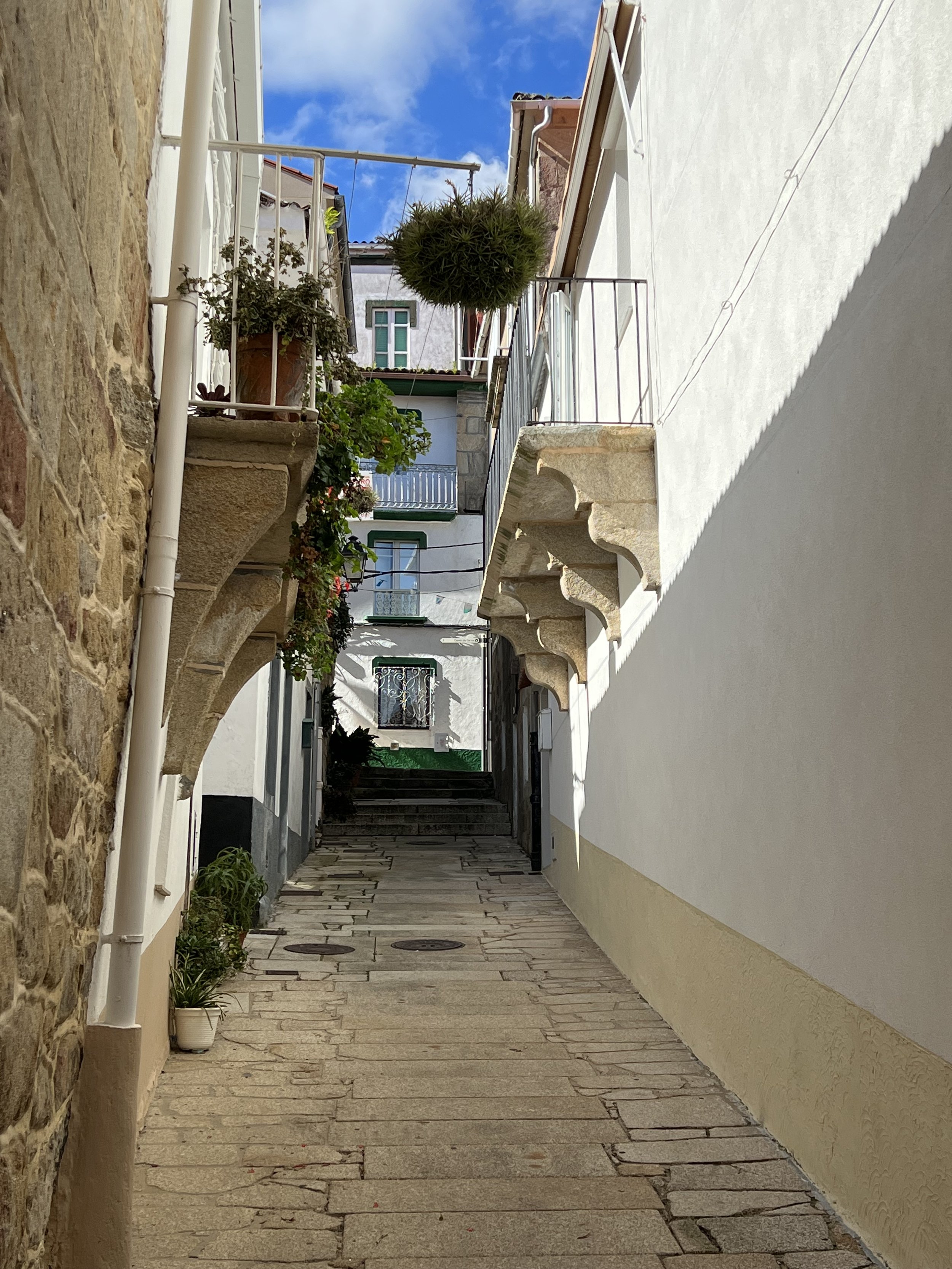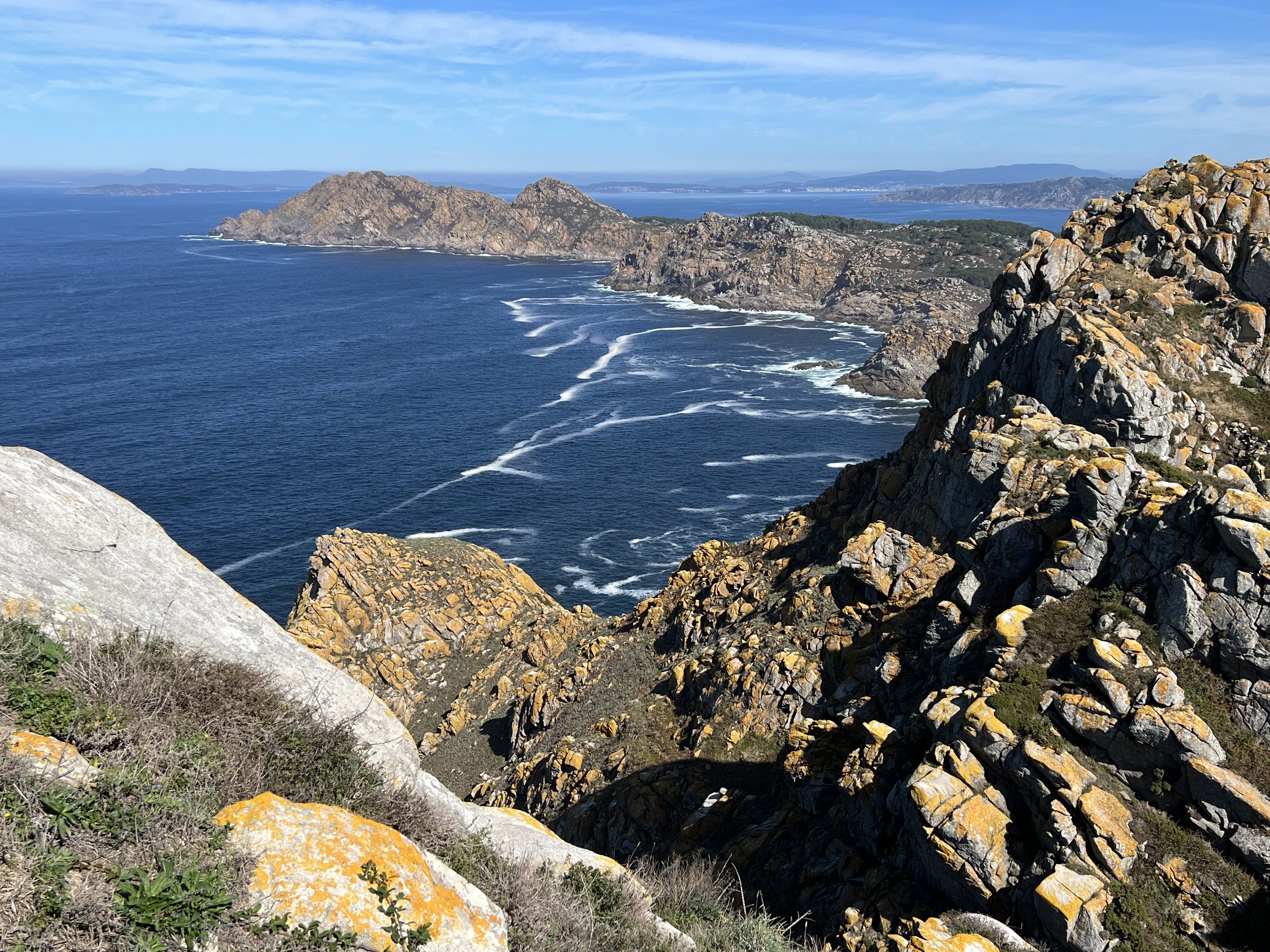Gorgeous Galicia.
Lighthouse off Cabo Villano
The sail from Å Coruna around the Costa da Morte, ominously named due to the rugged coastline and frequently inclement weather, was fine, fortunately, with no issues from weather nor orcas. All of our flotilla arrived safely in the first of the Rias of Galicia, Ria de Camariñas.
Camariñas
Camariñas is not the most pituresque of towns, it is a working fishing village with a small marina for pleasure craft. We anchored off the shore and took the dinghy in to explore with friends Mads and Ava from their boat Athena. We explored the town and discovered it is famous for its lace making. There was a lovely shop selling fine examples in addition to a museum and a statue honoring the lacemakers of Camariñas.
We walked around the waterfront and checked out the fishing boats where they were busy mending nets.. We had a most delicious lunch and then explored the back streets. We saw the first of many strange small sheds built up on high supports. We puzzled what they could be used for, drying hams? Storing grain? Drying grapes? We returned to the dinghy and found we had misjudged the tide, wet feet were in order to retrieve the dinghies. The following morning we bid farewell to Athena crew and headed south.
We sailed around Cabo Finisterre, the westernmost point in Europe, and tucked into Ria de Muros, the winds became quite strong toward the end of the day and we had to dock in the marina with 27kt crosswinds. Ria de Muros is the least developed of the rias and the old fishing town of the same name is very quaint. The maze of cobblestoned streets and 18th century stone buildings made it a very pleasant stop for a few days.
Muros
Muros church, built in 15th century.
Muros was a good place to leave the boat and go on an excursion to Santiago de Compostela. We took the 2hr bus ride which was a delight in and for itself, winding through the countryside and joined the pilgrims from all over Europe on the final approach up the hill to the cathedral the end point of the pilgrimage known as Camino de Santiago.
Cathedral of Santiago de Compostela.
The cathedral is massive and very ornate, but that is nothing compared with what we found inside. The altar under which the remains of Saint James, first disciple of Jesus and patron saint of Spain are buried is covered in gold leaf and has every variety of cherubim and seraphim dancing along the outside.
We explored the streets enjoying the beautiful buildings and colonnades.
The next day we left Muros and motored south into the first of many foggy days. The day warmed up and the fog cleared as we rounded the cape and headed for Isla Ons, one of the three barrier islands that protect the Rias from the Atlantic storms. We had previously applied for the permit giving us permission to anchor in the islands for the week, and started with the northernmost island. The anchorage was rather rolly and uncomfortable so the following day, anticipating similar swell after visiting friends Iain and Jackie of Fatjax we headed into the shelter of Ria Pontevedra and anchored off the fishing village of Combarro.
Granaries lining the waterfront in Combarro.
Here we finally learnt purpose of these small stone huts, they are granaries (horreo) for drying corn as feed for the pigs to make the delicious Galician hams. Combarro has an unusually high number for which it is known in addition to the eight stone crosses placed throughout the village. All the old fishing homes have at least one window facing the sea, to watch for the return of their loved ones.
After a couple of days we headed back to the barrier islands, Islas Cies, and anchored off the beautiful beach on Isla del Norte. Here we spent four relaxing days, waiting for the winds to take us south, out of Spain and into Portugal.
Isla del Norte















































